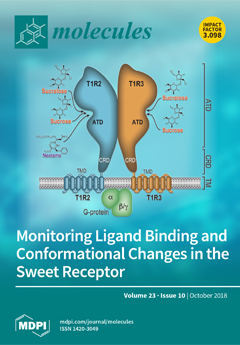Sibirioside A and angoroside C are two important phenylpropanoid glycosides of the traditional Chinese medicine Scrophulariae Radix. High performance liquid chromatography, coupled with an ion trap time-of-flight multistage mass spectrometry equipped with electrospray ionization source (HPLC-ESI-IT-TOF-MS
n), was applied to the profile
[...] Read more.
Sibirioside A and angoroside C are two important phenylpropanoid glycosides of the traditional Chinese medicine Scrophulariae Radix. High performance liquid chromatography, coupled with an ion trap time-of-flight multistage mass spectrometry equipped with electrospray ionization source (HPLC-ESI-IT-TOF-MS
n), was applied to the profile and we identified the metabolites of sibirioside A and angoroside C in vivo in rats. A total of four metabolites of sibirioside A were identified: SM1, SM2 and SM3 which were known as new compounds. A total of 25 metabolites were detected for angoroside C: AM4, AM5, AM6, AM7, AM16, AM17, AM20, AM21, AM22, AM23 and AM25 which were identified to be new compounds. The main metabolic reactions were hydrolysis, reduction, hydroxylation, methylation, sulfation, and gluconylation. The prototype of sibirioside A was widely distributed in tissues found in the heart, liver, spleen, lung, kidney, stomach and small intestine of rats, and mainly distributed in the stomach, small intestine, kidney and liver. But for angoroside C, nothing was found in the viscera except the stomach and small intestine. The metabolites of sibirioside A were mainly eliminated from feces, while it was urine for the metabolites of angoroside C. Furthermore, 19 metabolites were likely to have bioactivities based on the ‘PharmMapper’ analysis, which roughly matched the known pharmacological activities of Scrophulariae Radix (SR) and the prototypes. One of the main pharmacological activities of SR in traditional Chinese medicine is anti-diabetes, and the predicted results showed that SM1, SM2, SM3, AM2, AM4, AM5, AM6, AM9, AM10, AM11, AM12, AM13, AM15, AM18, AM19, AM24, and AM25 might be used to cure diabetes. These findings provide a reference for studying the metabolism, distribution and pharmacological actions of phenylpropanoid glycosides in vivo.
Full article






